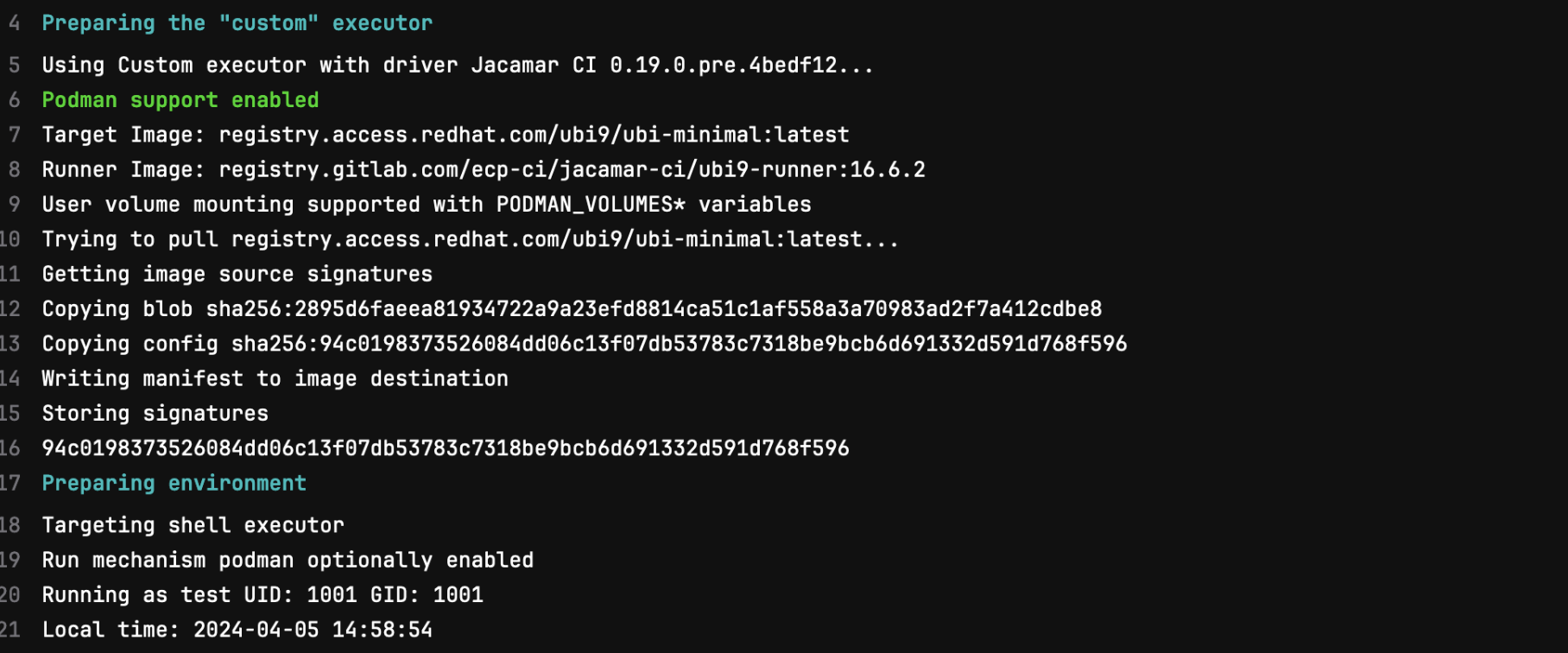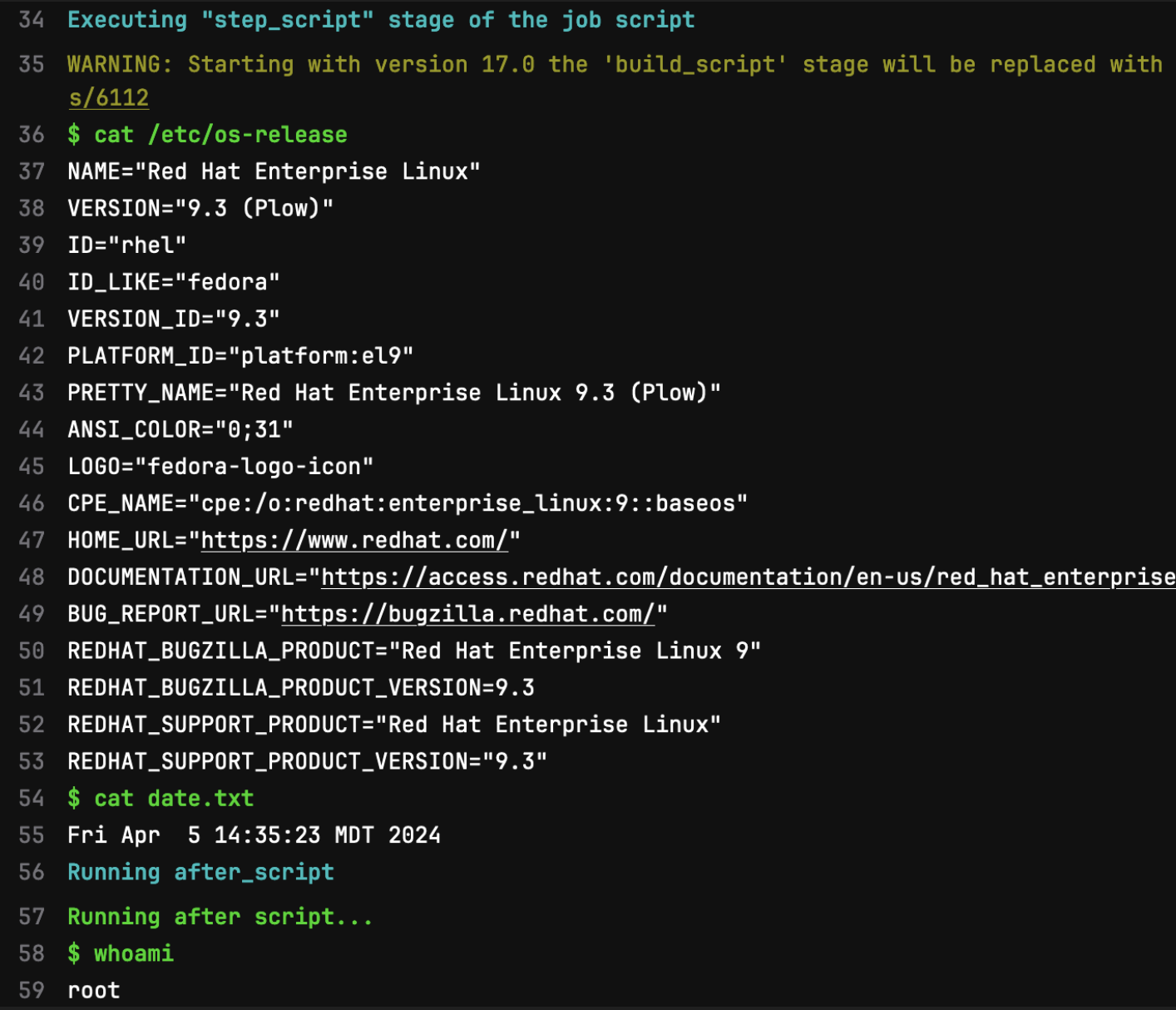Deploying and Using the Charliecloud Run Mechanism
Note
Support for Charliecloud as a run mechanism within Jacamar CI is a feature introduced in release v0.25.0. If you encounter any issues or have suggestions we would appreciate the feedback.
Jacamar CI is excited to support the use of Charliecloud to run jobs within
target containers while remaining in the user’s namespace. This is all done
while preserving support for existing executor types (e.g., shell and
flux). To understand how this functions it is first important to review
that every job Jacamar CI runs is based upon a script/environment/arguments
provided by the GitLab
Custom Executor.
The user application jacamar (traditionally ran after jacamar-auth has
authorized the job and dropped permissions) combines the runner generated
script with commands derived from the executor type and passes them to a
clean Bash login shell. The new Charliecloud run_mechanism modifies
this process to optionally leverage a ch-run command when users
provides an image in their Job:
With this new workflow we can ensure that the runner generated scripts are
always executed within the defined container while still potentially
submitting them to the desired scheduling system. The new mechanism also
handles the distinct runner generated stages (see
official docs)
by ensuring an administratively defined runner image is used where appropriate,
mounting all required volumes to preserve stateful information, and
automating registry credential management with the CI_JOB_TOKEN. The
resulting command would look something like:
/usr/bin/ch-run \
--write-fake \
--bind='<data-dir>/builds/ci-example_123/000' \
--bind='<data-dir>/cache/ci-example_123' \
--bind='<data-dir>/scripts/ci-example_123/000' \
'<data-dir>/scripts/ci-example_123/000/image.sqfs'
-- '<data-dir>/scripts/ci-example_123/000/build_script.bash'
Configuration
Note
The Charliecloud run_mechanism is only observed with the jacamar
application and is not utilized during any authorization steps.
It relies on an existing user namespace application
and all supporting configurations already established for your
specific environment.
[general] - Table
Key |
Description |
|---|---|
|
Defines a proposed mechanism to execute all runner generated scripts rather than simply relying on the user’s existing Bash shell. Use of this is dictated by the individual mechanism, for example with |
|
Requires the defined mechanism is used for all jobs, ignoring user setting/behaviors that normally trigger the usage. |
[general]
run_mechanism = "charliecloud"
force_mechanism = false
[general.charliecloud] - Table
Key |
Description |
Type |
|---|---|---|
|
Full path to the Charliecloud applications, used in constructing all commands. When not provided the application found in the users |
|
|
Helper image that will be used for standard runner manged actions (i.e., Git, artifacts, and caching). If not provided the host system will be used for these steps instead. |
|
|
Additional ch-run options that are used with the |
|
|
Override the default image pull-policy specifically for the |
|
|
This image is used when no user provided image is found (only observed when |
|
|
Additional ch-run options that are used in user’s job steps. |
|
|
Limits the use of containers to the step_script (user defined script combining the |
|
|
When defined only images that match this list of regular expressions will be allowed. |
|
|
Defines the prefix for a CI variable users can leverage to mount custom volumes at runtime. |
|
|
Allows for an admin defined script that is run during the |
|
|
Ignores any user defined arguments found in the |
|
|
Establishes the directory for setting the |
|
|
Prevents the use of ch-convert. |
|
Example
If you already have a functional Charliecloud deployment available you can add the following to your existing Jacamar CI configuration:
[general]
run_mechanism = "charliecloud"
[general.charliecloud]
# Allowing users to define their own mounted volumes is recommended but optional.
user_volume_variable = "CH_VOLUMES"
User dictated scripts (e.g., those from the before_script, script,
and after_script) will all be run using the image defined on the job
level. All other aspects of the job (e.g., Git, artifacts, and caching)
in this case will run on the host system.
To observe a simple example you can use the following job:
stages:
- host
- container
after_script:
- whoami
hello-host:
stage: host
script:
# This job runs on the host system because no image is provided.
- cat /etc/os-release
- date >> date.txt
artifacts:
paths:
- date.txt
hello-container:
stage: container
image: registry.access.redhat.com/ubi9/ubi-minimal:latest
# variables:
# Adding a variable like this will cause the string to be added to the
# --volume argument in the generated run command.
# CH_VOLUMES_0: ???:/example/scratch
script:
# Because we have defined an image our job will instead run using Charliecloud.
- cat /etc/os-release
# Artifacts are properly handled by the gitlab-runner on the host system
# and mounted into the container.
- cat date.txt
Examining the second job (which uses the Charliecloud mechanism) we can identify several important aspects:

We are still using a
shellexecutor, meaning the containers will run in the user’s environment on the machine the runner is hosted.In our test runner we still rely on
setuidto drop permissions and all aspects of the job observe this as you would expect. Noch-*commands are run until after authorization and downscoping have taken place.Build directories are still created in the defined
data_dirand mounted into the container at runtime following the same folder paths.During the
prepare_execstage the user defined image will be pulled and potentially archived based upon theexecutorconfiguration (i.e, batch executor converts images to a SquashFS in order to guarantee the are available on the compute resources).
Finally, we can clearly see that the user’s script is running in our UBI9 image and due to the correct mappings, features like artifacts/caching will be made available with no additional efforts required.

Custom Arguments
Unless disabled by configuration you can provide custom arguments to the ch-run command:
job:
variables:
JACAMAR_CI_CHARLIECLOUD_ARGS: "--set-env=FILE"
script:
- make test
Note that it is up to the user to ensure that these arguments do not conflict
with any defaults required to realize a successful CI/CD job. To help with
this the full ch-run ... command is always printed to the job log.
Defer to the official Charliecloud documentation for details on all options.
Authentication
As defined in the
authentication documentation
Charliecloud does not use configuration files, instead relies upon the
CH_IMAGE_PASSWORD and CH_IMAGE_USERNAME environment variables.
The priority of authentication options are as follows:
If user provided CI/CD variables are detected these are relied upon.
If the target image is from the same GitLab registry as the CI job itself we automatically inject the
CI_JOB_TOKEN.For all other cases, no authentication is provided.
SquashFS
By default we will utilize ch-convert in order to generate
a SquashFS archive of the image when using a batch executor. This
default behavior can be modified through configuration but care
should be given to ensure the new image_storage_dir is
accessible by the target compute resources:
[general.charliecloud]
disable_convert = true
image_storage_dir = "/target/dir"
Note
We are interested in improvements to how we manage/store converted images between jobs. However, at this time these flattened images will be removed automatically upon completion of the job.